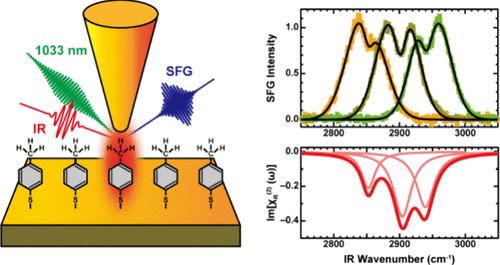分子振动纳米光谱学的尖端增强和频率生成
IF 9.1
1区 材料科学
Q1 CHEMISTRY, MULTIDISCIPLINARY
引用次数: 0
摘要
振动和频率生成(SFG)是一种非线性光谱技术,广泛用于研究表面体系的分子结构和动力学。然而,远场观测获得的空间分辨率受到衍射极限的限制,模糊了小于光波长的非均匀结构中的分子细节。为了克服这一限制,我们开发了一种基于扫描隧道显微镜的尖端增强SFG (TE-SFG)光谱系统。我们成功地检测了在环境条件下吸附在金衬底上的分子的振动TE-SFG信号。干涉SFG光谱的相位分析提供了分子取向的信息。此外,观察到的TE-SFG信号被证实来自尖端和样品衬底之间间隙内的高度局部区域。该方法为非线性纳米光谱学研究提供了一个新的平台,为研究超过衍射极限的表面分子体系铺平了道路。本文章由计算机程序翻译,如有差异,请以英文原文为准。

Tip-Enhanced Sum Frequency Generation for Molecular Vibrational Nanospectroscopy
Vibrational sum frequency generation (SFG) is a nonlinear spectroscopic technique widely used to study the molecular structure and dynamics of surface systems. However, the spatial resolution achieved by far-field observations is constrained by the diffraction limit, obscuring molecular details in inhomogeneous structures smaller than the wavelength of light. To overcome this limitation, we developed a system for tip-enhanced SFG (TE-SFG) spectroscopy based on a scanning tunneling microscope. We successfully detected vibrational TE-SFG signals from adsorbed molecules on a gold substrate under ambient conditions. The phase analysis of interferometric SFG spectra provided information on molecular orientation. Furthermore, the observed TE-SFG signal was confirmed to originate from a highly localized region within a gap between the tip apex and the sample substrate. This method offers a novel platform for nonlinear optical nanospectroscopy, paving the way for the investigation of surface molecular systems beyond the diffraction limit.
求助全文
通过发布文献求助,成功后即可免费获取论文全文。
去求助
来源期刊

Nano Letters
工程技术-材料科学:综合
CiteScore
16.80
自引率
2.80%
发文量
1182
审稿时长
1.4 months
期刊介绍:
Nano Letters serves as a dynamic platform for promptly disseminating original results in fundamental, applied, and emerging research across all facets of nanoscience and nanotechnology. A pivotal criterion for inclusion within Nano Letters is the convergence of at least two different areas or disciplines, ensuring a rich interdisciplinary scope. The journal is dedicated to fostering exploration in diverse areas, including:
- Experimental and theoretical findings on physical, chemical, and biological phenomena at the nanoscale
- Synthesis, characterization, and processing of organic, inorganic, polymer, and hybrid nanomaterials through physical, chemical, and biological methodologies
- Modeling and simulation of synthetic, assembly, and interaction processes
- Realization of integrated nanostructures and nano-engineered devices exhibiting advanced performance
- Applications of nanoscale materials in living and environmental systems
Nano Letters is committed to advancing and showcasing groundbreaking research that intersects various domains, fostering innovation and collaboration in the ever-evolving field of nanoscience and nanotechnology.
 求助内容:
求助内容: 应助结果提醒方式:
应助结果提醒方式:


